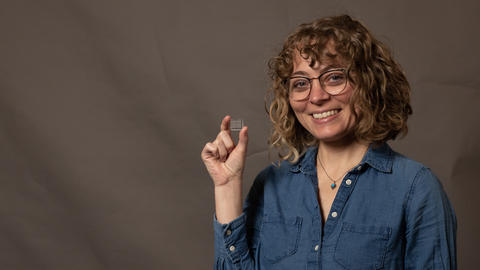Taking Measure
Just a Standard Blog
Benchy the Boat, Irradiated Mangoes, Quantum Window: A Sample of Stories on NIST Social Media
This is the place for seafaring 3D-prints, precisely dosed radiation, and laser-induced transparency. NIST’s research can range from the complex to the downright whimsical, but all the papers published here can trace back to a benefit for everyone in the U.S.
We’re catching you up on a few of the happenings at NIST, as told in the past few months on social media.
Toot, Toot! NIST Innovation in 3D Printing Takes a Familiar Form for the Industry

Do you know Benchy the Boat? NIST researchers certainly do, and the 3D-printing design is helping them make waves with a technique called vat photopolymerization.
To start off, Benchy (a nickname for “benchmark”) isn’t a NIST original work of art. More commonly referred to as #3DBenchy, the third-party, open-source design has been around for almost a decade, and many in the 3D-printing world have tested their machines with it. That’s because the boat contains challenging features for printers to overcome, such as pillars and overhangs.
Those features are especially challenging when using resins such as the one NIST researchers are working with.
Polyelectrolyte complexes (PECs) are resins with properties that make them potentially useful in fire protection, food packaging, drug delivery, insulation and more. They can erode in a water solution and are sometimes even biodegradable.
Now, for the first time, our researchers used PECs with a branch of additive manufacturing called vat photopolymerization. It’s a technique that uses light to solidify a liquid resin, layer by layer, into a 3D-printed shape.
As you can see here, the team 3D-printed the resin into none other than Benchy the Boat. They were able to control the sensitivity of PECs to water, making one version of Benchy that could degrade quicker than the other.
Then, to top it off, they took the dissolved remains of our boat friend and recycled them into a new part. This might sound cruel, but remember … this is not a person or even a boat. It’s a science project.
The results show a lot of promise for both the future of PECs and our hopes for a more circular economy. Find the full details in this paper, published via Advanced Science News.
Research Chemist Ileana Pazos’ Radiant Role in Longer-Lasting, Safer Imported Foods

Gamma rays and delicious mangos — fruits and vegetables brought in from outside the country first require health and foodborne pathogen inspections. NIST research chemist Ileana Pazos helps the process move safely along with her radiation expertise.
For some imported produce, the U.S. uses food irradiation. Also called cold pasteurization, it’s the process of applying radiation or energy to a food product. The resulting irradiated food has improved safety and an extended shelf life as well as no radiation residue on it, and the radiation does not compromise the nutritional quality. That means radiation can make food safe to eat (and even last longer).
But for food irradiation to work safely, we need precise measurements of the absorbed radiation dose, all traceable to the International System of Units (aka the metric system). That’s where Ileana comes in.
At NIST, Ileana tests the accuracy of the dosimeters — devices that determine the amount of radiation absorbed from gamma rays — that industry leaders use in their own facilities. She also sends NIST’s own dosimeters out to companies so that they can calibrate the dose delivered by their machines.
As it turns out, Ileana isn’t the only one in her family whose work at NIST has dealt with internationally traded goods.
Her mother, Ileana Martinez, worked at NIST for many years. She served as the standards representative at the U.S. Embassies in Argentina and Brazil, under a memorandum of understanding between NIST and the Department of Commerce’s International Trade Administration. In this role, her mother worked closely with metrology institutes in South America and provided technical support to the U.S. ambassadors and commercial counselors. The program aided U.S. companies in overcoming standards-related barriers to trade.
Ileana grew up already knowing about NIST because of her mother’s work and joined our Summer Undergraduate Research Fellowship program, designed to inspire college students to pursue careers in STEM. As a postdoctoral researcher at the University of Maryland, she also collaborated with NIST and later joined our workforce.
The mother-daughter duo just missed each other’s paths. Ileana started at NIST right after her mother retired. But it seems the work in standards runs in the family, and that’s something we (and our imported goods) can get behind.
Researcher Aly Artusio-Glimpse Opens a Quantum Window Into RF Measurements

Antennas need lots of calibration steps for consistent, accurate measurements of radio frequency (RF) fields.
But there’s a new way, and it’s right here at NIST researcher Aly Artusio-Glimpse's fingertips.
This new way uses atomic physics. Here’s how it works:
Aly and her colleagues set up a small glass box (a vapor cell, such as the one shown here) filled with atoms in a high-energy state, called Rydberg atoms.
They shine two lasers through it and detect the transmitted power of the first, the so-called probe laser. Shining only the probe laser through, little light reaches the detector on the other side. The rest is absorbed by the atoms in the vapor cell.
Then, Aly and her team beam another laser with a different color into the vapor cell, and something weird happens.
The light from the first laser shouldn’t be getting through, but the second laser opens a window of sorts through the atoms so that the probe light can pass through unabsorbed. This is an effect known as electromagnetically induced transparency, or EIT.
From there, they can expose the cell to RF fields and make very precise measurements. Setting up EIT with Rydberg atoms might seem like a highly complicated process to replace antennas, but it has major advantages:
- Atoms don’t need to be calibrated because their behavior is the same everywhere in the universe, in line with International System of Units (SI) definitions.
- It’s done entirely with glass, not metal. That minimizes RF scattering, so military operations using it to communicate won’t reveal their locations.
- There is a much larger range of frequencies that we can cover, from megahertz (your typical FM radio) to terahertz (a wavelength approaching visible light).
Good thing we have researchers such as Aly to get these experiments going.
To get news like this and other updates, follow NIST on social media:
- National Institute of Standards and Technology
- National Initiative for Cybersecurity Education
- Organization of Scientific Area Committees
- Communications Technology Laboratory
- Manufacturing USA group
- Manufacturing Extension Partnership
YouTube






How did you irritate the mango?